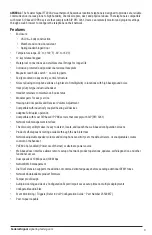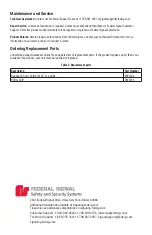
8
Federal Signal
signaling.fedsig.com
Connecting a Device to an Auxiliary Relay
The FT200C-VoIP Telephone incorporates a one on-board relay located on the PCBA, which enables users to control a
low current external relay or device. An external relay can control a ringer, strobe light, door lock, or any other apparatus.
The on-board relay is protected by a 1 A, non-replaceable fuse. Power switched by the relay should not exceed the rating
of the fuse. Consideration of a safety factor is recommended.
The relay circuitry contains a non-replaceable 250 Vac 1 A fuse. If the fuse blows, the board must be returned to
Federal Signal or an approved service center for repair.
The telephone relay activation time is selectable through the web interface on the Device Configuration Page. The relay
can be controlled by DTMF tones generated from the monitoring phone to which the VoIP phone is connected or by other
methods. Refer to VoIP Configuration Guide – Part Number 25500857.
NOTES:
•
The three-digit code for the auxiliary relay must be sent in conformance with RFC2833 DTMF generation.
•
Firmware version 3.4.0 or later requires a “#” to execute the DTMF command.
Example: 321# - activate relay.
See Figure 7 and Table 3 to identify the connector locations and functions.
Figure 7 Connector Locations
Table 3 Connector Functions
Connector
Function
J1
PoE Network Connection (RJ-45)
J2
Hands free Microphone Interface/LED Interface
J3
Not used
J4
JTAG Interface
J5
Handset/Reed Switch Interface
J6
Speaker Interface
J7
Keypad Interface
J8
RS232 Port
J9
Terminal Block (see Figure 5)
J10
Not used
J11
Handset V.C. Interface
J12
ISP-DIP/Debug UART






























